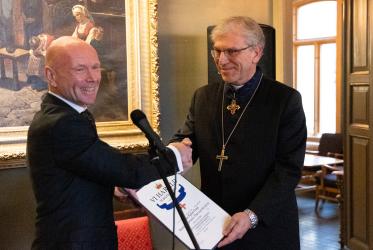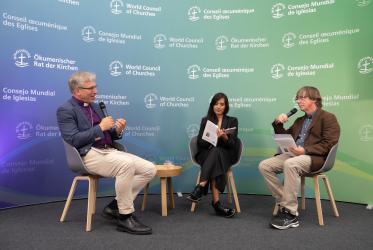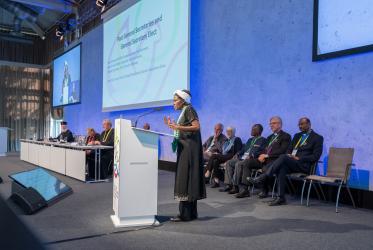Sermon by Rev. Dr Olav Fykse Tveit, WCC general secretary
Morning prayers at the Ecumenical Centre
26 April 2010, first day of the WCC Staff Planning Week
When it was evening on that day, the first day of the week, and the doors of the house where the disciples had met were locked for fear of the Jews, Jesus came and stood among them and said, "Peace be with you." After he said this, he showed them his hands and his side. Then the disciples rejoiced when they saw the Lord. Jesus said to them again, "Peace be with you. As the Father has sent me, so I send you." When he had said this, he breathed on them and said to them, "Receive the Holy Spirit. If you forgive the sins of any, they are forgiven then; if you retain the sins of any, they are retained."
John 20: 19-23
Dear fellow disciples of Christ!
In most families there are a few stories that are told time and again. One of my favourites was the one my mother called “Då freden kom” - “When the peace came”.
She told many stories about life as a student nurse in the occupied city of Oslo during World War II. These were stories about the shortage of food, about the empty streets at night, about the hard work of carrying the patients down to the bunkers every night when the air raid alarms sounded, and the long hours of waiting. These were stories about the darkness and fear of war.
However, one story she told again and again with an unceasing joy in her eyes was the story of when the peace came. It was almost as if peace was a person: with a real presence, coming, being, breathing, staying.
Word about the peace had begun to spread as a rumour already on the 7th of May 1945. However, all the radios had been confiscated throughout the war, so how could you know the truth? The rumour in itself sparked hope, just one word changed the whole mentality, the whole perspective of life. Nevertheless, she always emphasized that they did not really dare to believe it until the next day. My mother would always describe in a very lively way the three proofs that made everyone sure the next day that peace had come.
First of all, they could see people everywhere, talking openly to one another in the streets, even singing and shouting loudly. Secondly, the Norwegian flag which had been abandoned for five years, was hanging everywhere; without fear people carried it in the streets. The third proof was in the fires in the streets. Open fires, burning the compulsory paper blackout curtains, which had covered every window of the city of Oslo every night for five years. So as not to give any clue to the bombers of where the streets and buildings were, no light should beam into the streets during the night. This made the city dead and dangerous in the long winter nights. Now these hated curtains were burning.
The open conversations, the flags in the wind and the burning curtains were strong symbols of what peace means. Peace is when we can speak openly to one another without fear, the freedom to be myself and yourself, sharing everything openly, even with joy. The flags became the symbol of justice, the freedom to believe that justice would prevail and belong to everybody. The burning curtains became the symbol of freedom to be recognized, to show that you are there, that you are alive, becoming part of the life of the city, without fear.
The feeling of what the coming of peace means can only really be experienced by those who have been living with the fear of war, the suffering of injustice, the burden of waiting for the day of peace and new life to come.
And yet her story of when the peace came always sparked a deep feeling of joy in my heart. And it still gives me a deep sense of gratitude and longing; even more so since being here in this ministry and in our focusing on what a just peace means. The more I see the realities of life for many people in this world, in different kinds of conflicts and injustice, the more the story of when the peace came becomes a story of hope and solidarity: listening to the longing for justice and peace; longing that something wonderful will happen, that it must happen.
We are always met by this word in the church: Peace! Peace be with you! What a word! What a reality! Peace coming to us, sometimes as a surprise, even when we have heard it before.
To his disciples meeting in fear behind locked doors the risen Christ says: "Peace be with you. As the Father has sent me, so I send you." And he breathes on them.
We are always sent from church or from chapel with that same word, to make that same reality known: Peace! So that the doors can be unlocked, the rooms can be open, so that the streets can be filled, so that the hearts can open by themselves.
Glory be to the Father and to the Son and to the Holy Spirit, as it was in the beginning, is now, and will be for ever and ever.
Amen.



